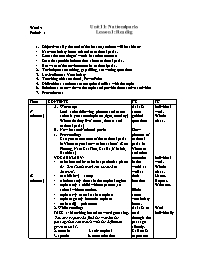Giáo án English 10 - Unit 11: National Parks - Lesson 1: Reading

1. Objectives: By the end of the lesson, students will be able to:
- Use vocabulary items related to national parks.
- Guess the meaning of words based on contexts
- Scan for specific information about national parks.
- Be aware of the environment in national parks.
2. Techniques: matching, gap filling, answering questions
3. Lexical items: Vocabulary
4. Teaching aids: textbook, PowerPoint
5. Difficulties: students are not quite familiar with the topic
6. Solutions: narrow down the topic and provide them active activities
7. Procedures:
Bạn đang xem tài liệu "Giáo án English 10 - Unit 11: National Parks - Lesson 1: Reading", để tải tài liệu gốc về máy bạn click vào nút DOWNLOAD ở trên
Week: 1 Unit 11: National parks Period: 1 Lesson 1: Reading Objectives: By the end of the lesson, students will be able to: Use vocabulary items related to national parks. Guess the meaning of words based on contexts Scan for specific information about national parks. Be aware of the environment in national parks. Techniques: matching, gap filling, answering questions Lexical items: Vocabulary Teaching aids: textbook, PowerPoint Difficulties: students are not quite familiar with the topic Solutions: narrow down the topic and provide them active activities Procedures: Time CONTENTS T’S TS’ (7 minutes) (8 minutes) Warm up: Look at the following pictures and name animals you see (elephants, tiger, monkey) Where do they live? (zoos, forests and national parks) New lesson: National parks Pre-reading: Can you name some of the national parks in Vietnam you know or hear about? (Cuc Phuong, Nam Cat Tien, Cat Ba, U Minh, Bach Ma) VOCABULARY: to be located in: to be in a particular place Ex: Ben Thanh market is located in district 1. establish (v) = set up rainforest (n): forest in the tropical region orphan (n): a child without parents, an animal without mother. orphan (v): to make sb an orphan orphanage (n): home for orphans toxic (adj) = poisonous 2. While reading: TASK 1: Matching based on word guessing. You are required to find the word in the passage that can match with the definition given in task 1. 2. contain 5. sub- tropical 3. species 6. contamination 4. survival TASK 2: Complete the table below National parks Cuc Phuong Nairobi Everglades Location South-West of Hanoi, Vietnam In Kenya In the South-East United States Special features butterflies, caves, 1000- year- old trees 200 sq km rain forest large variety of animals & plants. lots of orphaned animals are taken care of. plants & animals from both tropical & temperate zones. toxic levels of chemical in the water. TASK 3: Answering questions by playing a game: Lucky animals (8 animals) (The area of the rainforest in Cuc Phuong National Park) 200 square km Because the rainy season is over. They can learn about the habits of animals and how one species is dependent upon another for survival. In the Orphanage and/or abandoned animals are taken care of. Everglades National Park is endangered because of the toxic levels in the water. 3. Post-reading: Discussion: What should we do to protect national parks? Why? Suggested answer: C/ HOMEWORK: Summarize the main points. Assign homework. Asks Ss some guided questions Show pictures of national parks in Vietnam and other countries in the world as well as their location Elicits some vocabulary items. Asks Ss to read through the passages silently. Call on Ss to present and explain their answers. Plays a song and aks Ss to pass the 3 given markers to pick 3 random pairs. Divides the class into 4 groups Asks Ss to name their group as their favorite kind of animal. Individual work. Whole class. Individual work. Whole class. Listen. Repeat. Write out. Work individually Work in pairs. Read out loud their answers. Use this information for the next task. Group work. The winner group will get a chance to present their discussion for the next task. Whole class
Tài liệu đính kèm:
 Unit_11_National_parks.doc
Unit_11_National_parks.doc





